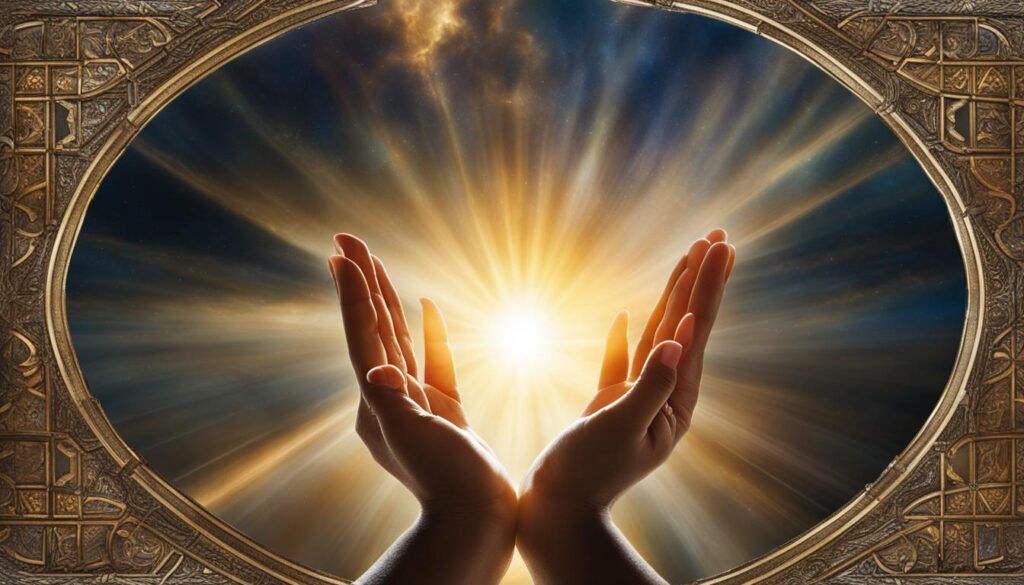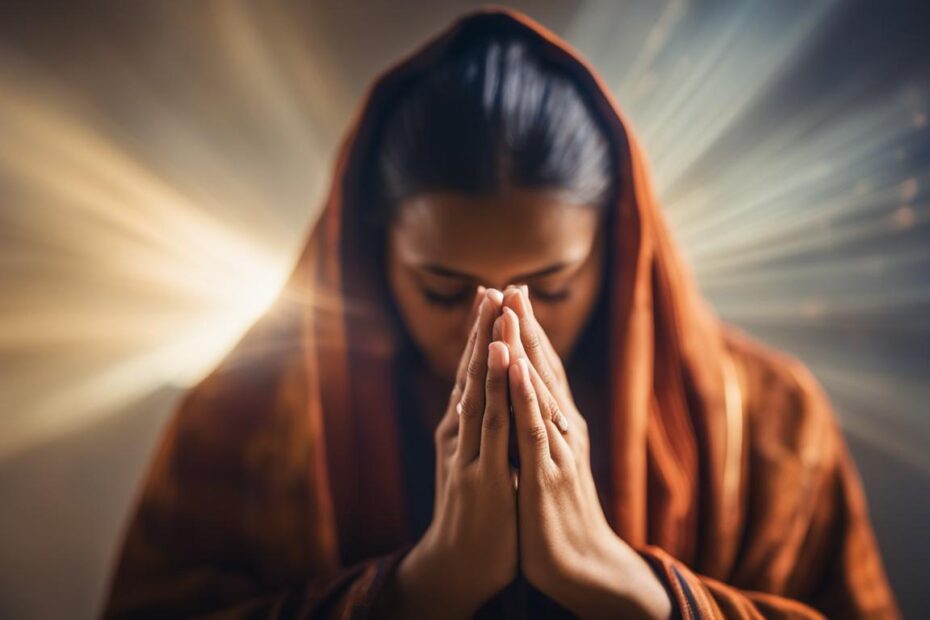Supplication hands, also known as prayer gesture or raising hands in prayer, hold deep significance in many religious and spiritual traditions. It is a way of opening oneself up to receive blessings and positive energies. The position of the hands during prayer symbolizes surrender, humility, and a recognition of a higher power. This article will explore the power and meaning of supplication hands in various spiritual practices.
Key Takeaways:
- Supplication hands symbolize surrender, humility, and openness to receive blessings.
- The position of the hands during prayer bridges the physical and spiritual realms.
- Prayer is a powerful practice that fosters a deeper connection to one’s spiritual journey.
- In Islam, supplication (Dua) is a form of communication with God.
- The Bible highlights the miraculous works accomplished through God’s hands.
The Symbolism Behind Supplication Hands
Supplication hands, also known as prayer gesture or raising hands in prayer, hold deep symbolic meaning in various spiritual traditions. This gesture is not merely a physical position but a profound expression of surrender, humility, and openness to receive blessings. When individuals open their hands during prayer, they symbolize their readiness to connect with a higher power and submit to divine guidance.
Supplication hands serve as a bridge between the physical and spiritual realms, embodying the connection between heaven and earth. The upward position of the hands signifies reaching towards the divine, while the downward position represents receiving blessings and grace. This symbolism adds depth to the act of prayer and enhances its transformative nature.
Throughout history, different cultures have incorporated various hand gestures and postures in prayer rituals. These gestures, including supplication hands, deepen the spiritual experience and create a sense of reverence and devotion. They remind individuals of their place in the grand scheme of the universe and their dependence on a higher power.
Symbolic Hand Gestures in Different Traditions
The symbolism behind supplication hands varies across different spiritual traditions. For example, in Hinduism, the gesture of raising the hands in prayer is called “anjali mudra” and represents respect and gratitude. In Buddhism, the prayer gesture is known as “anjali” and signifies an offering of goodwill and reverence. Similarly, in Christianity, raising the hands in prayer is a symbol of surrender and an invitation for God’s presence. These interpretations reflect the diverse ways in which supplication hands are understood and celebrated in various spiritual practices.
| Tradition | Hand Gesture | Symbolic Meaning |
|---|---|---|
| Hinduism | Palms pressed together | Respect and gratitude |
| Buddhism | Hands held in front of the chest | Offering of goodwill and reverence |
| Christianity | Raised hands | Surrender and invitation for God’s presence |
The power of supplication hands lies not only in their symbolic nature but also in their ability to create a spiritual connection. By understanding the deeper meaning behind these hand gestures, individuals can enhance their prayer experiences and cultivate a stronger sense of spiritual connection.

The Power of Prayer in Various Traditions
Prayer is a powerful practice that plays a significant role in different religious and spiritual traditions. It serves as a means of communication with the divine and fosters a deeper connection to one’s spiritual journey. The act of prayer involves various hand movements and positions, reflecting the reverence and devotion individuals hold towards their faith.
In Hinduism, prayer often involves hand gestures known as mudras. These mudras hold symbolic significance and aid in focusing the mind during prayer. For example, the Anjali mudra, where the palms are pressed together at the heart center, represents gratitude and respect. It is a physical manifestation of the individual’s devotion and surrender to the divine presence.
Mudras in Hinduism:
| Mudra | Meaning |
|---|---|
| Anjali Mudra | Gratitude and respect |
| Gyan Mudra | Wisdom and knowledge |
| Abhaya Mudra | Fearlessness and protection |
In Buddhism, prayer involves various hand gestures known as mudras as well. The Bhumisparsha mudra, where the right hand touches the earth while the left hand rests on the lap, represents the moment of the Buddha’s enlightenment. This mudra serves as a reminder of the power of perseverance and determination in one’s spiritual journey.
Mudras in Buddhism:
| Mudra | Meaning |
|---|---|
| Bhumisparsha Mudra | Enlightenment and awakening |
| Dharmachakra Mudra | Teaching and preaching |
| Vitarka Mudra | Discussion and intellectual debate |
These hand movements and positions in prayer rituals across various traditions enhance the spiritual experience and create a sense of connection to the divine. They serve as reminders of the power of prayer and its ability to bring peace, guidance, and transformation to individuals on their spiritual path.
Understanding Dua: Supplication in Islam
In Islam, supplication, known as Dua, holds a special place in the spiritual practice of Muslims. Dua is a form of communication with God, where individuals express their needs, desires, and gratitude. Muslims believe that Allah is always near and responsive to their prayers. Dua encompasses a wide range of supplications, including raising hands in prayer, as a physical manifestation of surrender and seeking divine guidance. The essence of Dua lies in recognizing one’s dependence on Allah and seeking His mercy and blessings.
Dua is an integral part of daily life for Muslims, as it provides a means to connect with the divine and seek solace, guidance, and blessings. It is a powerful tool that allows individuals to express their innermost thoughts and emotions, knowing that Allah is listening and capable of answering their prayers. The act of raising hands in supplication signifies an act of humility and acknowledgment that one is in need of divine intervention. Muslims believe that through Dua, they can find peace and strength in times of difficulty, and experience a deep sense of connection with God.
“And your Lord says, ‘Call upon Me; I will respond to you.’ Indeed, those who disdain My worship will enter Hell [rendered] contemptible.”
The act of raising hands in prayer is a symbol of trust and reliance on Allah’s infinite wisdom and power. It is a way for believers to demonstrate their complete surrender to the will of God and seek His guidance in every aspect of their lives. Through Dua, Muslims strive to align their thoughts, intentions, and actions with the divine principles and seek Allah’s mercy and blessings.
The Power of Dua in Daily Life
Throughout the day, Muslims engage in various forms of Dua to seek blessings, express gratitude, and ask for forgiveness. From the moment they wake up in the morning to the time they go to bed at night, Dua is an integral part of their routine. It serves as a constant reminder of their connection with Allah and the importance of seeking His guidance in all matters.
Whether it is a simple prayer for guidance before making an important decision or a heartfelt plea for healing and well-being, Muslims turn to Dua as a means of finding strength, solace, and closeness to Allah. The act of raising hands in supplication serves as a physical reminder of their faith and reliance on the divine.
Overall, Dua is a powerful and transformative practice in Islam. It allows Muslims to establish a deep connection with Allah, seek His guidance, and experience His love and mercy. Through Dua, believers find solace in times of hardship, gratitude in times of abundance, and a sense of purpose in their daily lives.

The Miraculous Works of God’s Hand: Biblical Perspective
Throughout the Bible, numerous verses depict the power and miraculous works of God’s hands. These verses serve as a testament to the divine intervention and providence that God offers to His people. The symbolism of God’s hand signifies His strength, guidance, and provision in the face of adversity.
One such example is found in Exodus 14:21-22, which describes how God, through the stretch of His hand, parted the Red Sea, allowing the Israelites to escape from the pursuing Egyptian army. This remarkable act of deliverance showcases the miraculous works that God can accomplish through His divine touch.
In Psalms 139:10, it is written, “Even there shall thy hand lead me, and thy right hand shall hold me.” This verse illustrates the comfort and protection that comes from knowing that God’s hand is guiding and supporting us in every step of our journey. It reassures believers that they are never alone and that God’s hand is always there to provide help and sustenance.
“The Lord is my rock, my fortress, and my deliverer, my God, my rock in whom I take refuge, my shield, and the horn of my salvation, my stronghold.” – Psalm 18:2
This passage from Psalm 18 emphasizes the strength and protection that comes from seeking refuge in God. It highlights the unwavering support and deliverance that God’s hand offers to those who put their trust in Him.
| Table: Miracles Through God’s Hand in the Bible |
|---|
| The parting of the Red Sea – Exodus 14:21-22 |
| Guidance and support – Psalms 139:10 |
| The rock, fortress, and deliverer – Psalm 18:2 |
The miracles portrayed in these verses remind believers of the extraordinary power that resides in God’s hands. They inspire faith, courage, and a deep sense of awe in the presence of divine intervention. By reflecting on these biblical perspectives, individuals can find solace and hope, knowing that God’s hand is always at work in their lives, ready to perform miracles beyond human comprehension.

The Potency of Prayer and the Importance of Persistence
Prayer is a powerful practice that has the ability to transform lives and bring about positive change. It is a means of seeking guidance, finding solace, and experiencing the presence of the divine. The potency of prayer lies not only in the act itself but also in the mindset and persistence behind it.
When we engage in prayer, we are opening ourselves up to connect with a higher power and align ourselves with God’s will. It is a way of acknowledging our dependence on something greater than ourselves and seeking guidance and blessings. However, prayers may not always be answered in the way we expect or within our desired timeframe. It is crucial to remain persistent in our supplications and have faith in the acceptance of prayers. The act of persistently praying demonstrates our trust and belief in the power of the divine to bring about miracles and fulfill our heartfelt desires.
Just as we would water a seed and patiently wait for it to grow, persistence in prayer is essential for nurturing our spiritual journey. It is through persistent prayer that we develop resilience, deepen our connection with the divine, and strengthen our faith. It is a reminder that even in times of doubt or uncertainty, we can find solace and hope in our prayers. The importance of persistence in dua, or supplication, cannot be understated, as it allows us to maintain a consistent and dedicated relationship with the divine, regardless of the circumstances.
As the saying goes, “Prayer changes things, and prayer changes people.” When we persistently pray, we open ourselves up to the transformative power of prayer. Whether it is in times of joy or adversity, prayer serves as a constant source of strength, guidance, and comfort. By remaining steadfast in our supplications and trusting in the acceptance of prayers, we invite the divine to work miracles in our lives, align our paths with God’s will, and bring about positive transformations that surpass our understanding.
| Benefits of Persistent Prayer |
|---|
| 1. Strengthened faith and spirituality |
| 2. Enhanced sense of peace and inner calm |
| 3. Guidance and direction in life’s challenges |
| 4. Deepened connection with the divine |
| 5. Alignment with God’s will and purpose |
By persistently engaging in prayer, we tap into the profound potency of this spiritual practice. It is through persistence that we demonstrate our unwavering commitment, trust, and belief in the divine. In doing so, we invite blessings, experience transformation, and embark on a journey of spiritual growth and enlightenment. The power of prayer lies not only in its ability to bring about external changes but also in its capacity to inspire inner transformation and shape our souls.
Conclusion
Supplication hands hold profound significance in various spiritual traditions. By assuming the prayer gesture, individuals symbolize their surrender, humility, and willingness to receive blessings and positive energies. This act of opening oneself up to a higher power fosters a deeper connection to one’s spiritual journey.
Prayer, in its essence, is a powerful practice that allows individuals to communicate with the divine. It serves as a means of seeking guidance, finding solace, and experiencing the presence of a higher being. Through supplication hands and other prayer gestures, individuals can enhance their spiritual experiences and invite positive transformations into their lives.
Whether it is through the Islamic tradition of Dua or the biblical perspectives of God’s hands, the potency of prayer is evident. Prayer has the ability to align individuals with God’s will and bring about positive changes. It is a practice that offers a sense of peace, guidance, and fulfillment on one’s spiritual journey.
As individuals explore the power of supplication hands and delve deeper into the realm of prayer, they embark on a transformative journey. They open themselves up to the vast possibilities that lie within and connect with the divine forces that surround them. May the power of prayer and the symbolism behind supplication hands continue to inspire and guide individuals on their spiritual path.
FAQ
What is the significance of supplication hands?
Supplication hands hold deep symbolic meaning in many religious and spiritual traditions. They represent surrender, humility, and openness to receiving blessings and positive energies.
What does it mean to raise hands in prayer?
Raising hands in prayer signifies readiness to receive and surrender to a greater force. It is a gesture of humility and recognition of a power greater than oneself.
How do supplication hands bridge the physical and spiritual realms?
The position of the hands, whether upwards or downwards, symbolizes the connection between heaven and earth. It represents the bridge between the physical and spiritual realms.
What is the power of prayer?
Prayer is a powerful practice that fosters a deeper connection to one’s spiritual journey. It brings peace, guidance, and transformation to individuals on their spiritual path.
How is supplication incorporated into Islamic prayer?
In Islam, supplication, known as Dua, is a form of communication with God. Muslims raise their hands in prayer as a physical manifestation of surrender and seeking divine guidance.
What does the Bible say about God’s hands?
The Bible depicts God’s hands as instruments of divine power and intervention. They are associated with strength, guidance, and provision in numerous biblical verses.
How can prayer bring about positive changes?
Prayer aligns individuals with God’s will and has the power to bring about positive transformations in their lives. It is important to remain persistent in supplications and have faith in the acceptance of prayers.
Source Links
- https://guideposts.org/prayer/bible-resources/bible-verses/encouraging-bible-verses/20-bible-verses-that-show-us-the-miraculous-works-of-gods-hand/
- https://tarteel.ai/blog/understanding-the-power-of-making-dua/
- https://community.thriveglobal.com/hands-to-receive-while-clinching-fists-to-believe-the-power-of-prayer/








